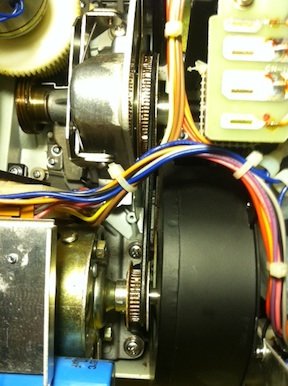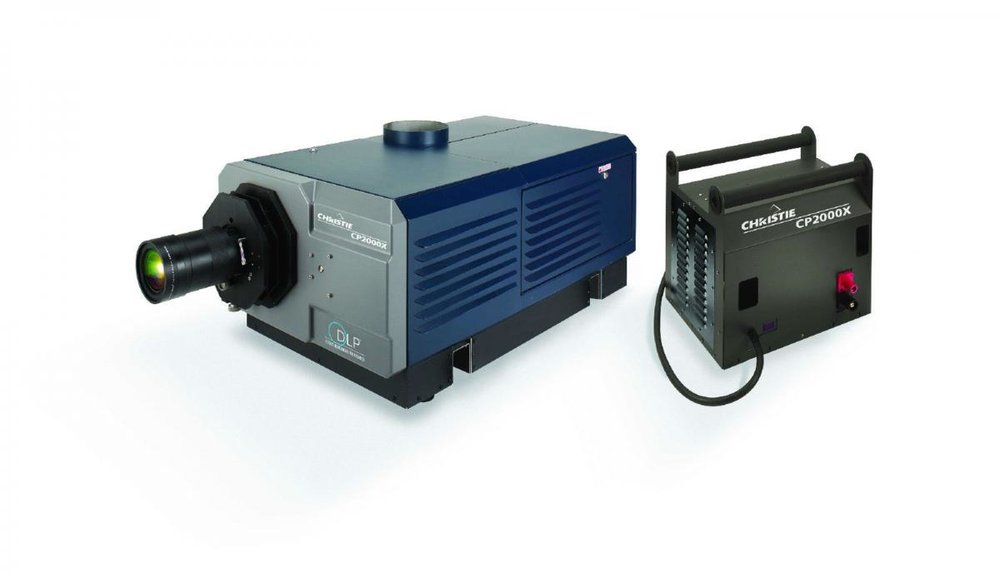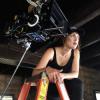Search the Community
Showing results for tags 'projection'.
-
I am working on the film looping installation but I found loading on the looper is pretty hard to get 'balanced'. As I understood, ideally looping system has to reel and unreel film more or less same amount film so it won't stuck or become large film donut? I load the film with spacer on inner circle and remove it later, so whole film roll could rotate smoothly on the looper plate and it could release. It runs well for a while without any problem but after certain moment you can see the whole film circle is getting smaller or bigger which lead the looper stuck with film or make the film out of track(plate). It doesn't happen always same point or duration of time so I feel it almost randomly happen. Barely it runs on 'balanced' mode, but I have no idea why. and what did I do. Is there basic general rules or warnings that I have to mind? I guess the amount of film and the type of the looper would be another factor, I'd like to run 100 to 150m length film if possible.(but I'd like to find stable way first even if shorter length) Any advice would be very much appreciated. Thank you.
-
I was hoping someone could explain to me how the drive system on a platter works, pertaining to the film speed. Obviously, as the film empties off of one platter, it has to turn slower. What adjusts the motor to keep it turning at the appropriate speed so the film doesn't unravel onto the floor?
- 5 replies
-
- projection
- projector
-
(and 1 more)
Tagged with:
-
Good evening from Spain! I have a shooting in two weeks where they want a rear projection, it's an exterior day and we have a 6500 lumens projector and a 300x225 cm retroprojectable screen. Will I need more lumen output in the projector in order to have my image sharp? I've done this before but not in shootings, just in live events, where the projection quality is not mandatory to be clean and sharp. I will pack some additional large black cloth to try blocking sun going through the screen, but I'd appreciate some more tricks! Thanks a lot and happy new year!
-
I've been mulling what it would take to make a lens from scratch, particularly a projector lens. With proper machining equipment, I believe I could construct every part of the lens except the actual glass elements themselves. As far as designing the optics, instead of ordering custom glass elements, I could take advantage of the low cost of mass produced elements from companies like Edmund Optics. However, I'm wondering just what kind of tolerances in the glass thickness would be acceptable. For example, in an old episode of "How It's Made", they show the construction of a Canon EF 500mm F4 L IS USM lens, a $9000 lens, and they mention that the glass elements have a tolerance of +/- 0.001mm. That kind of a lens has far more precision than I would need. The cheapest elements from Edmund Optics however have a tolerance of +/- 0.1mm., something I would guess is way too low, but I'm not sure. This is for projecting Super16 film in a modified projector. Really, I don't think I would need better precision than what you would find in a $100 DSLR kit lens. My question is: What kinds of tolerances would be acceptable, and/or what kind of precision is used in mass produced kit lenses.
-
Does anyone know of any research of how projected film and its inherent dark "frames" affect our perception of the story? I heard murch talking a bit about it but havent been able to find anything... (If clarification is necessary : Double shutter required to project 24 fps film thus our brains through persistence of vision do not include, but are subjected to moments of darkness)
- 6 replies
-
- fps
- projection
-
(and 1 more)
Tagged with:
-
Shared it in the Super 8 forum but figured such huge news warranted a post here as well! Kodak is reviving Ektachrome 100D!! http://www.kodak.com/US/en/corp/Press_center/Kodak_Brings_Back_a_Classic_with_EKTACHROME_Film/default.htm
- 89 replies
-
- 1
-

-
- super 8
- ektachrome
-
(and 3 more)
Tagged with:
-
The goal is to recreate the classic/cheesy effect of driving in a stationary car but projecting a moving background environment behind the car so it looks like he's driving. http://pics.imcdb.org/784/electionprojectionmercedes.jpg I'm going to shine a projector on a white cyc wall behind the car and do mainly frontal shots. Any reccomendations on specifically which projector I should rent for this? Model name? If not, approx. how many lumens should the projector be to match the brightness of the background in the photo above? I'm sure rear projection through some type of glass is what's normally used, but I dont believe we will have access to something like that at the white cyc studio. Also any tips?
- 2 replies
-
- projector
- projection
-
(and 2 more)
Tagged with:
-
Hi all, The Elmo CL (Xenon) I am borrowing is running around 28 fps. I've seen posts and the Elmo manual explaining that an incorrect running speed can be changed by moving the belt to the different set of pulleys, changing between 50 & 60 Hz. However this model I'm working with only has one set of pulleys. Maybe this is a newer model? On the serial number plate it does say both 50 & 60Hz. There is room on the teethed pulleys for the belt to move to the left but I swear it is the same tension. No significant difference. Not sure what else to do. Appreciate any suggestions. -alee
-
- 16mm
- projection
-
(and 2 more)
Tagged with:
-
For sale is a CHRISTIE CP2000X DLP Cinema HD-2K Projector and Christie 7 KW Ballast. The machine is in good working condition and free of technical defects. We can also service your projector. Contact for more details, picture is reference only. Price $13,000.
-
- Cinema
- Projection
-
(and 2 more)
Tagged with:
-
I was at a trade show where someone was showing me a dedo light and made the mistake of showing me the projector attachment. I was very excited by the gobos and spent ages with the few they have coming up with new trippy effects. I definitely decided I wanted one of these but then later when I looked into it the cost was very scary. Hundreds and hundreds of pounds for the lighting fixture and then the projector attachement too. I started looking around at alternatives in the theatrical world and that was when I stumbled across the Ikea Isbrytare lights and managed to snag 5 at £7.50 each! So I am now very happy! Obviously these aren't proper lighting fixtures being more like mutated birdie lights and while I am waiting for them to get here I'm also aware that they are only 50W MR16 lights so aren't going to be super powerful. I'm hoping to modify size M gobos to work with them. So I'm wondering if anyone has any gobo tips or has used gobos a fair bit. I realise they are often more of a theatrical thing but I'd love to hear anything anyone has to say about them. Freya
- 127 replies
-
- 1
-

-
Hey everyone, So for this low budget commercial I'm shooting, I'd really love to have a stronger light at a distance to get a "shafts of light through window" gag with haze. It's just not in our budget so I'm trying to find the best way to get a large parallel beam into a small space (the room is only 15'x19') and I feel like the M18 could be a way to do this. I'd also consider using a Joker Leko setup but I'm just afraid it won't produce as large or powerful of a beam as the M18. Arri describes the M18 as having the best aspects of a par and fresnel - personally I love this light and I've been able to produce some venetian blind gags in small spaces with it before. I know an ordinary par wouldn't work at such a close distance. My question is, do you think the beam of the M18 is parallel enough to make a gag like this? Thank you, Chris
-
Hello! I'm shooting a short film on B&W 35mm (this is a strict decision of the director and I- it's set in the 1960s are we feel that shooting film is crucial to this story). We have quite a few scenes in a 'beach house' set where the windows look out onto the ocean. We will need to digitally project an ocean outside the windows but my concerns are - how do we get the brightest image so that the outside is overexposed than the inside? I know I will have to shoot wider open so the projector overpowers the light sources inside. we are thinking of putting up a giant white muslin around the outside of the windows and doing something similar to what Claudio did on Oblivion. http://www.fdtimes.com/2013/03/29/claudio-miranda-asc-on-oblivion/ the only problem being that we can't afford 21 projectors. Perhaps only two or three. Does anyone have any better ideas for this? Is front projection the best way to go? Thank so much. Kate
- 4 replies
-
- projection
- 35mm
-
(and 2 more)
Tagged with:
-
Supervising colorspaces in different parts of the chain. As I understand it, Digital Cinema Projections are in P3 colorspace, and TV/DVD/Web is rec.709 colorspace. Then, as for the workflow. Images are captured in colorspace X (depending on the camera/stock) In the DI, images are converted to another colorspace, lets just say ACES In the master the images are then converted into either P3 or Rec.709 depending on the format. My questions are, 1. How do we know which colorspace we are exporting to? E.g. What colorspace does H.264, ProRes422 (HQ) or ProRes4444 have? Can you recommend any places to read up on this? 2. And how do we ensure to keep colors within the intended colorspace, as to not lose out of gamut colors when exporting? 3. I often use a Kodak2383 emulsion LUT when grading which clips out of gamut colors and remaps them to the closest color of same luminance. I suppose the gamut / colorspace is calculating what can be printed to Kodak2383 film. Do you know of any way that I can see / test how wide this colorspace is compared to P3 and rec.709? 4. I work with dailies & grades in photoshop as references for the colorists. Can you recommend a website where to read about color-management in photoshop as to stay within gamut, and 5. Would you recommend any specific image format. DPX, TIFF or PNG etc. for colorspace and accurate color rendition? Thanks guys, Will
- 12 replies
-
- color space
- p3
-
(and 5 more)
Tagged with:
-
I'm shooting a person with images being projected on them by a Epson 8350 Digital Projector. I want to shoot at a high frames per second (120fps) or a high as I can get a way with... The problem is the viewfinder and monitors show an unwatchable bad amount of pulsing light flicker. Does any one have any advice on how to do slow motion with a projector light in the shot and on a subject to mitigate or preferably all together stop flicker/pulsing light look?
-
Hello to all, I have a shoot coming up, shooting using Sony F3 cameras, editing in FCP7. The set is a white 3-wall cyc; the 2 side walls being covered with floor to ceiling gray curtains and the back wall plain. As part of the set dressing the director wants to project images such as the below link onto the back wall during shooting. [www.videoblocks.com] Does anyone foresee any problems with this in post? It's been suggested that the video image would flutter and we should only project still images onto the wall as opposed to video. Thoughts/suggestions to make this work? Thank you, Lisha
- 1 reply
-
- cyc
- VideoBlocks
-
(and 1 more)
Tagged with:
-
I am shooting in a studio with some soft HMI lighting, using only a 1.2K and a 2.5K, both with diffusion or bounced for a gently-lit daylight look. Shooting against a 35' white cyc, with the subject 15' away from the cyc. We want to light the cyc and subject separately with projected color fx images. Any idea on how much lumens we should be looking for in a projector?
-
Hello everyone, We are planning to shoot a very low budget feature film this summer and I have some questions on the camera set we will use and I hope you can help me on some of the following: 1. The 16:9 sensor on the GH2 + a 2x anamorphic adapter produces a final stretched anamorphic aspect of 3.55. Which would result in (1920x1080)*(2)= 3840x1080. Instead of doing the decompression from 2x, I want to interpret the shot as if pixels would be 1.333 or 1.4587. I know it keeps the image still a little deform but I think I like the look. Whats your technical and/or creative take on it? (SEE IMAGES BELOW) 2. We would project it on standard 2k (2048×1080) DCP cinemas and the final cut would fit into it with a 2048x858 (2.39:1) size movie. Am I right? or does it work in another way? 3. I am currently using Sedna AQ1 for max detail against anamorphic softening against big screen projection. Do you think it will hold enough? Would you sharpen in post? Whats you recommend any other hack? Given this 3 points which would be your opinion on this process? Have any of you seen any gh2 anamorphic content projected in 2k dcp? How does it stand? Thanks for your help! P.D. Anyone selling a Kowa 16-h (8z) In order not to be so limited with the 16D in lens minimum mm´s?
- 3 replies
-
- gh2
- anamorphic
-
(and 5 more)
Tagged with:






